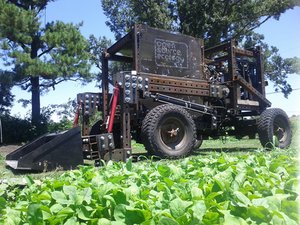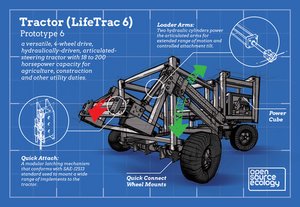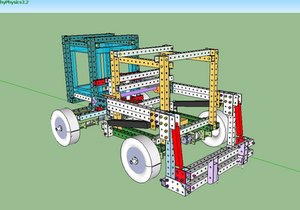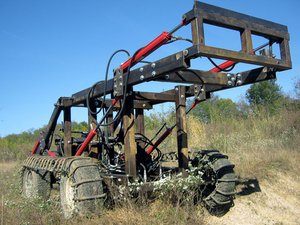|
No Answers 2 Score |
Can I download these blueprints? |
|---|---|
|
No Answers 1 Score |
What is the Cost of parts,? |
|
No Answers 0 Score |
Lower profile Lifetrac with trailer function |
|
No Answers 1 Score |
Where is the STL file? |
The LifeTrac Story

This insane freak purrs like a cat and rips the ground. Major success.We have now demonstrated a workable design with LifeTrac 5. We took the articulated joint that was present in LifeTrac I - to allow long-life on the shafts - which experience much less wear compared to skid steering.
The frame is bolted together from 1/4″x4″x4″ mild steel square tubing. 4 modular wheel units snap right on the frame. Quick-connect hoses are used throughout for plug-and-play interchangeability of parts. 1 ro 4 PowerCubes can be used.
The flexibility of the design is extraordinary – wheel motors are detachable and have quick couplers. The valves are detachable and has quick couplers. The hoses have quick couplers. This means that all these hydraulic components may be used elsewhere, as part of a flexible Lego set for real technology. Moreover, the quick disconnects allow this tractor to operate in 2 wheel drive and 4 wheel drive.
We know of no other machine in this world which features this level of part interchangeability or modularity. This is a feature that allows one to control equipment costs to the lowest possible – not only by repurposing components, but being able to service or repair the machine readily.
It turns out that 27 horsepower – or a single PowerCube unit – is quite satisfactory for driving this basic tractor.
If you would like to replicate this tractor - we suggest it only if you are an early adapter and if you can resolve some of the outstanding issues:
1. Redesign of loader arm attachment
2. Reduction in the size of the Power Cube compartment
3. Redesign of curl cylinder
Hydraulic system refinement to allow 3 or 4 power cubes.





